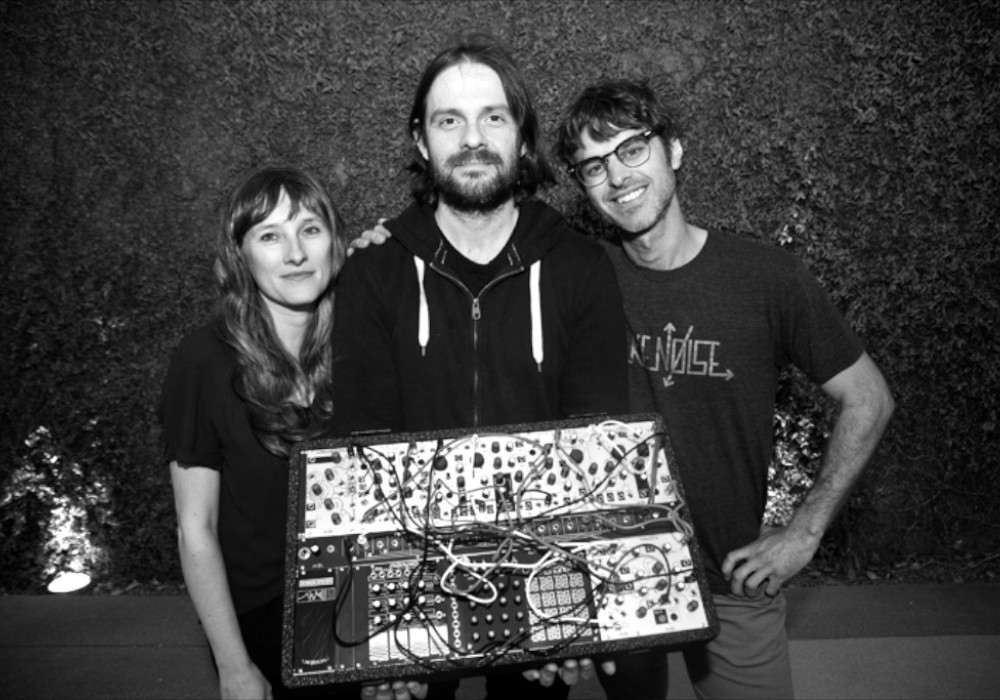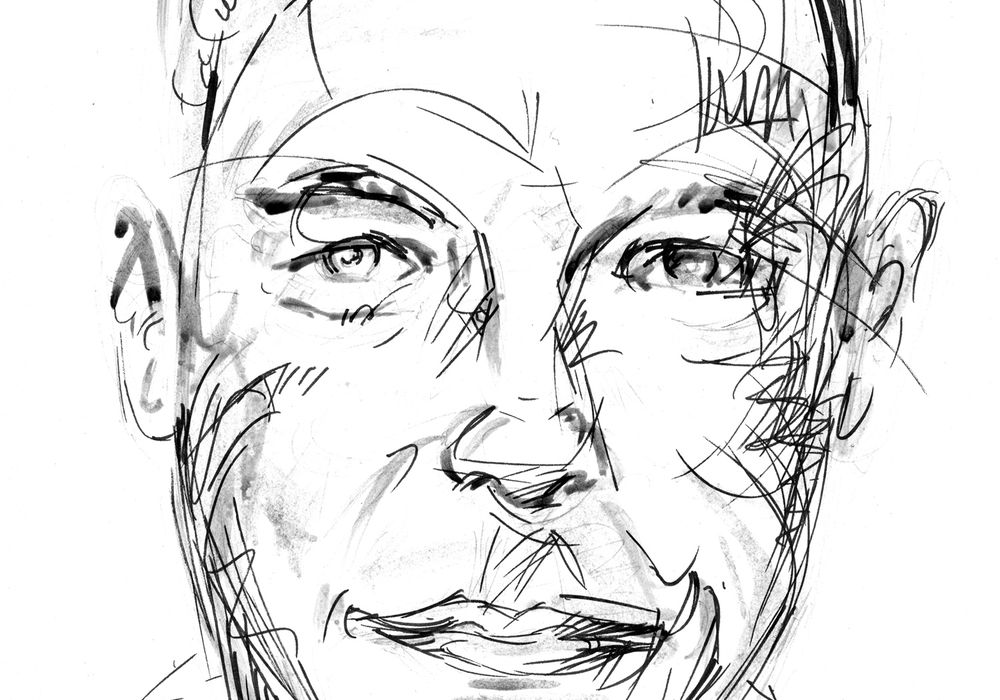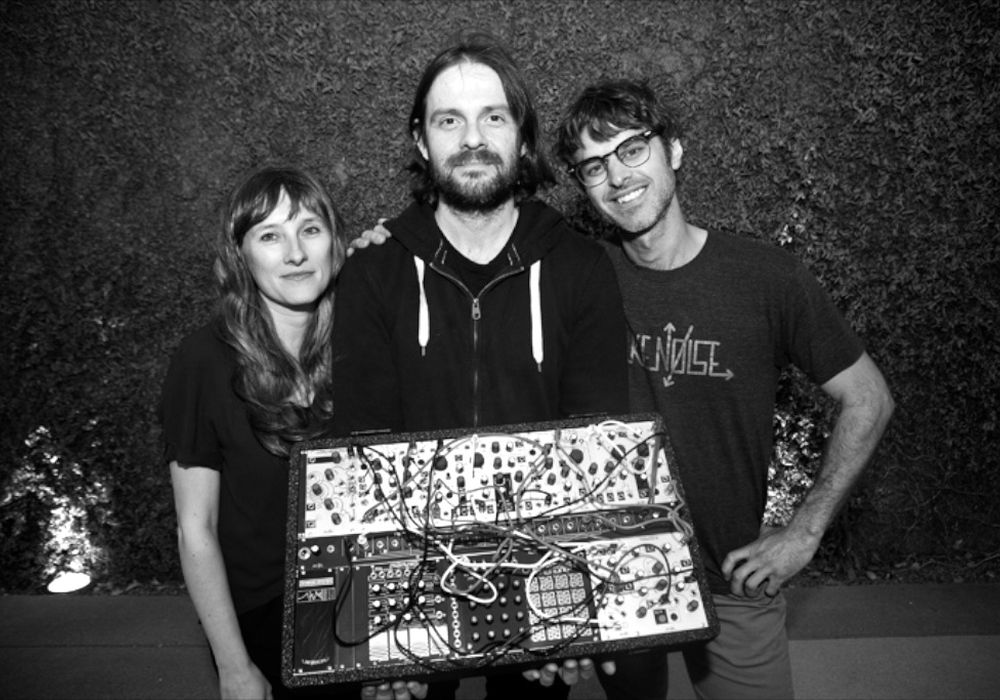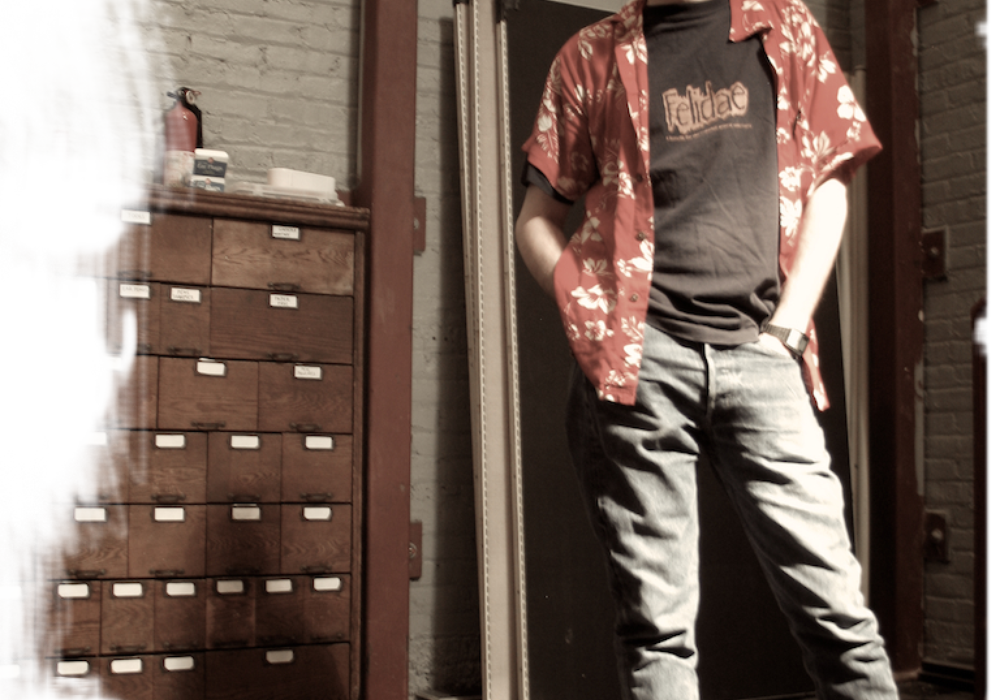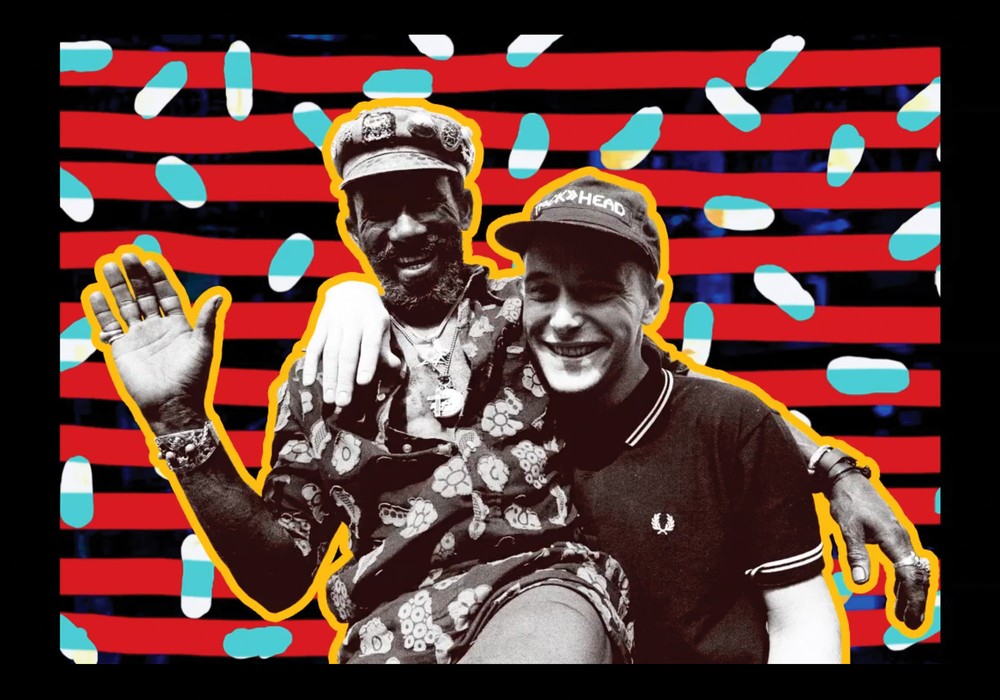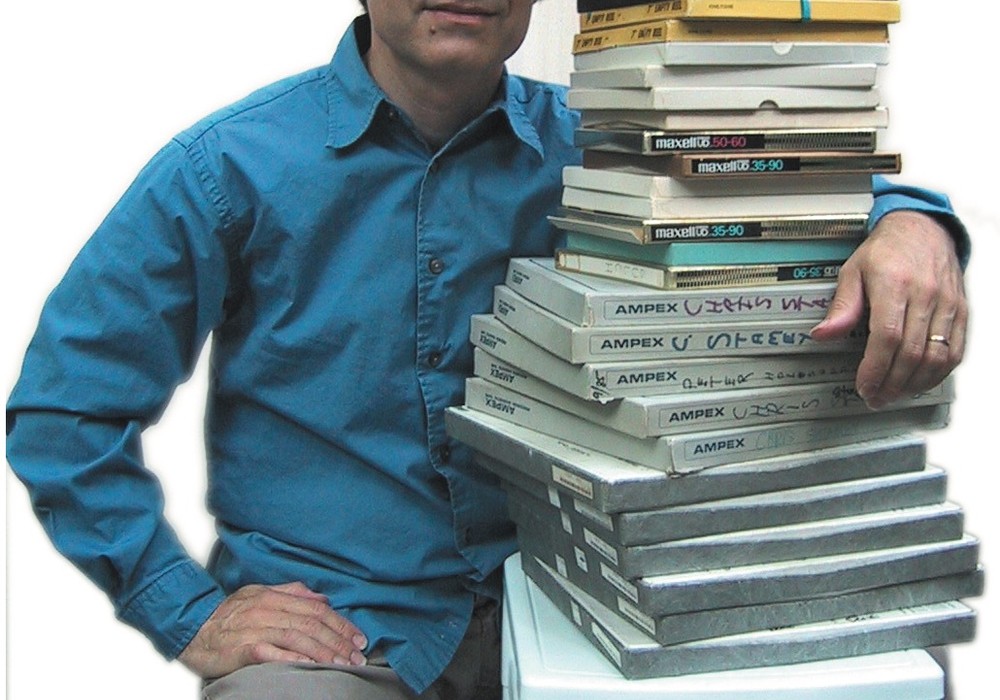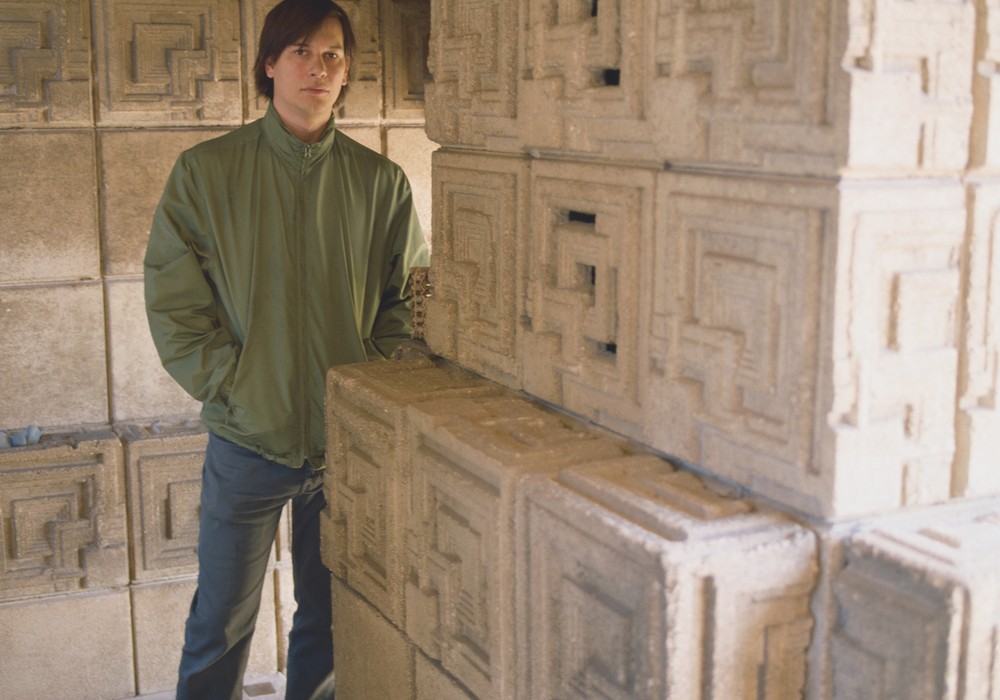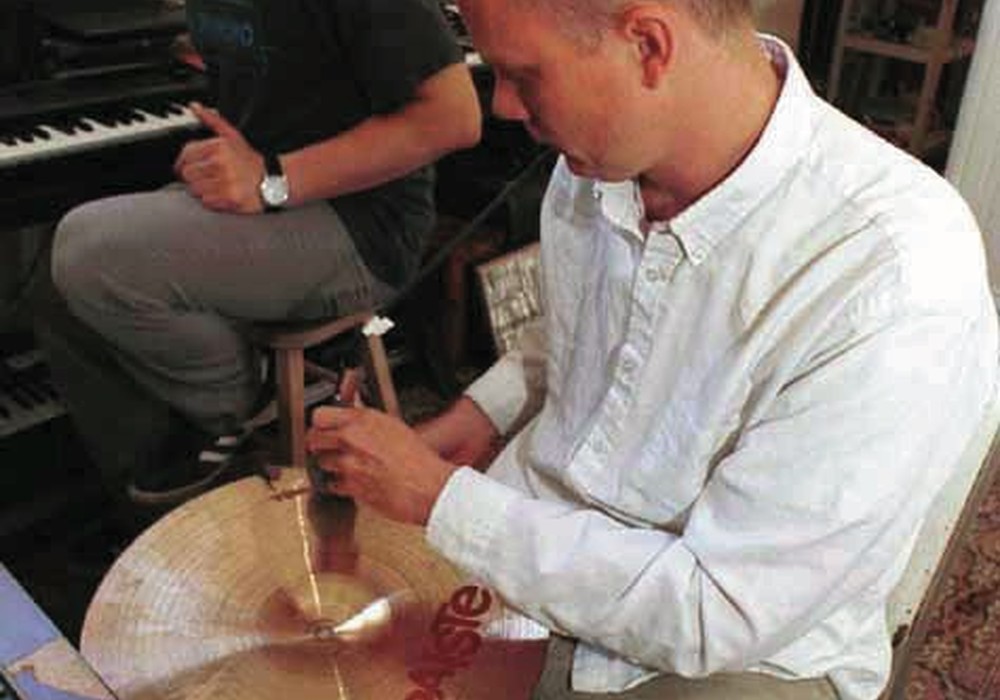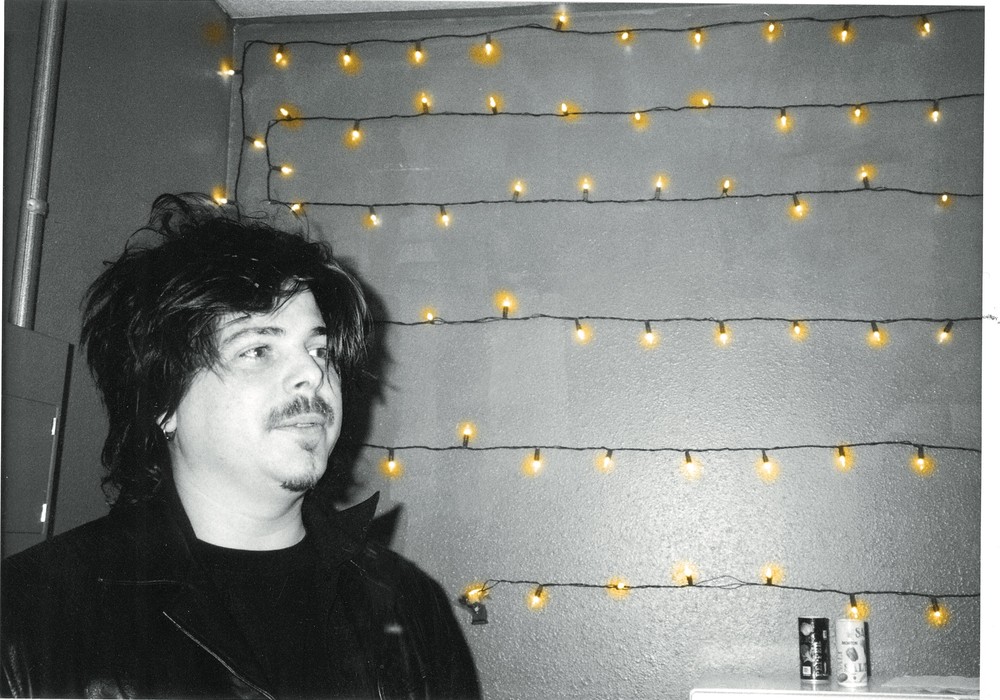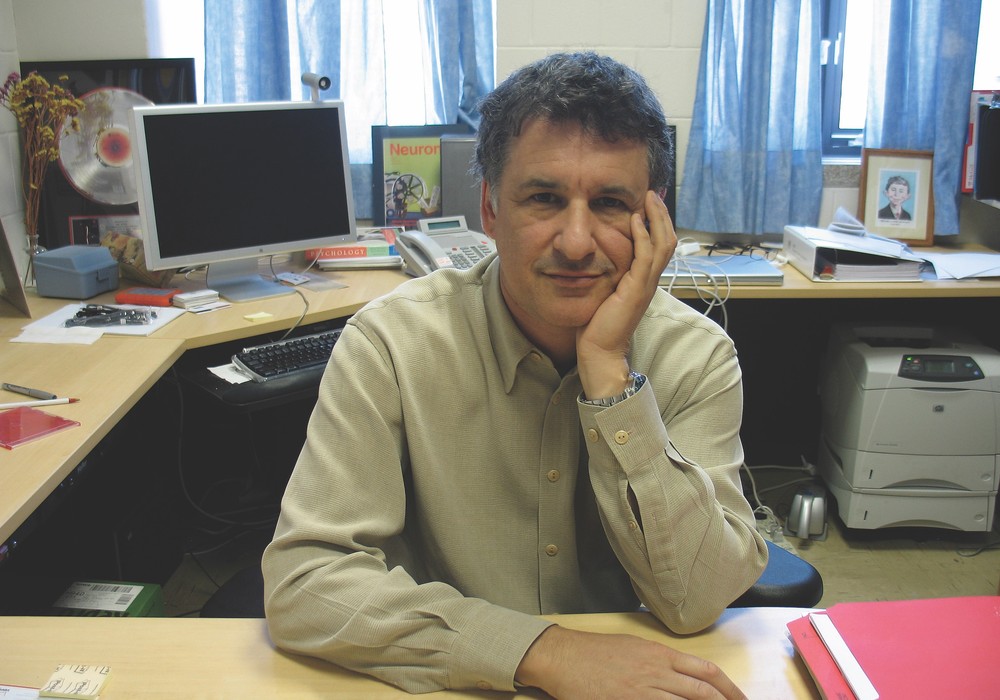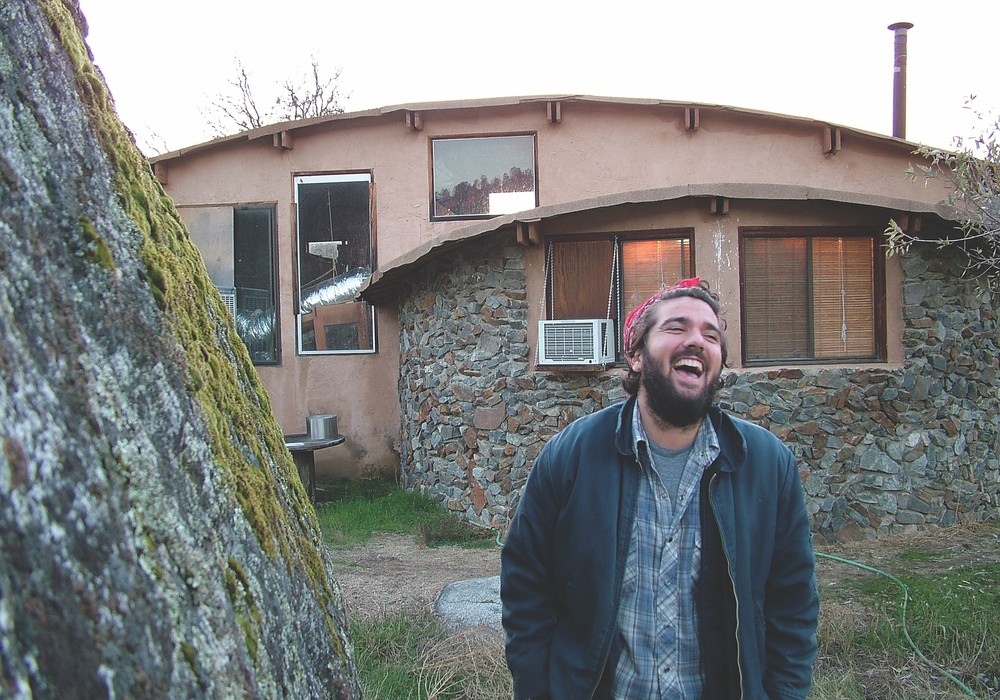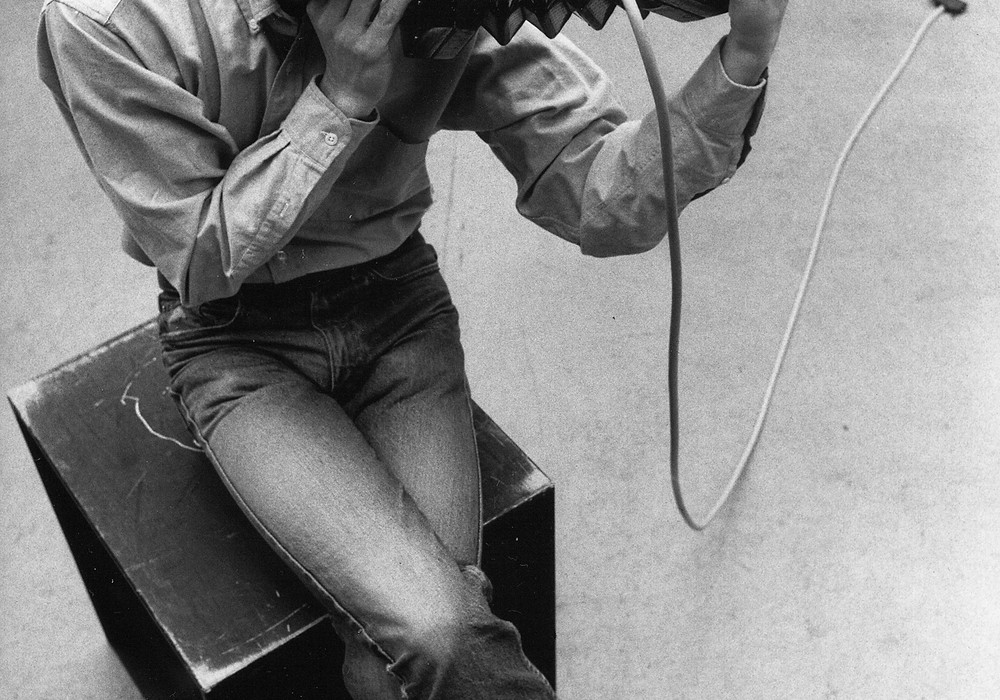It only makes sense that with a renewed interest in analog synthesis, modular synths would make a comeback. However, rather than the hulking beasts Keith Emerson tortured on stage, or pampered studio dwellers, like TONTO, the new Eurorack style systems are lightweight, portable and powerful, owing to the inclusion of modern technology, compact circuitry, and new ideas. Tony Rolando and Kelly Kelbel run Make Noise, a modular synth company in Ashville, North Carolina.
Kelly told me that you learned electronics on your own.
Tony: I'm completely self-taught. About ten years ago I went to the library and dug up every book I could find on analog circuit design. I wanted to know how synthesizers worked. I started trying to build stuff. Most of it didn't work immediately, but eventually I figured it out.
What first got you interested in synthesizers?
Tony: I've just always been interested in them. One of the first times I saw a modular was around '94, when Jim O'Rourke walked into a club in Chicago with a suitcase, took off the lid, patched some modules together, and did a set. Looking back I think it was an early Doepfer P6, but I didn't know anything at the time. It was really hard to find out about modulars, because the Internet wasn't completely in place yet. The second time was in New York City. A guy walked into a music shop, trying to trade in a basic, two row Doepfer system. They didn't want it, and he walked out. I considered following him and trying to offer him some money, but I had no idea how much it was worth.
Kelly: Tony started building drone boxes in New York. The first thing he got paid for was around 2002, when he made a light-controlled audio mixer, which was part of an art installation for Simon Lee. 1,000 pinhole cameras inside of a bus.
Tony: The pinholes were set up, as if the bus was the camera body, and you were inside, so as you rode through Manhattan, literally thousands of [moving] images being beamed into it.
A rolling camera obscura?
Tony: Exactly. He had hired musicians to compose a soundtrack for the ride. The visuals were dependent on the weather, time of day, and route. He wanted the soundtrack to be changeable, depending on the environment. The mixer had light sensors on the outside of the bus. The light would control the levels of individual tracks. Essentially, the tracks were being remixed by the bus ride.
So from there, what was your first job in this field?
Tony: Moog Music. We went to Asheville to visit some friends, and the Citizen-Times headline was that Bob Moog had passed away. Kelly thought they might need some people, and encouraged me to call. They said they might be hiring, and we arranged an interview. They just put me in a room with a schematic, pointed at stuff, and asked me what it was. It was pretty simple. They just wanted to see if I knew anything at all. I passed the test, so they gave me the job. I learned a lot about building electronic instruments there.
What was your job there?
Tony: Moog was still really small. The Little Phatty hadn't come out yet. I did warranty work and service for stuff that failed right off the production line. I ran the Voyager quality control line for quite a while. There were only 20 people there back then. People had many jobs, so I even worked in shipping every once in a while. Moog was just a warehouse at the time. There were a couple of windows in the front, but once you got inside, there was no sign of daylight! I worked there for about three years. The current space is really beautiful, with big windows.
Kelly: Everybody's got to start somewhere. The last Make Noise space was 400 square feet with really weird carpet and one window. It was really stuffy, and we were all on top of each other. We were only there for a few months.
While you were with Moog, were you developing what would ultimately become Make Noise?
Tony: Not really. I was building stuff for myself, and sometimes for musicians around town. They'd bring me some old stompbox so I could add an expression input or something. Sometimes people brought me old Moogs to fix, which was funny. New Moogs don't really have anything to do with the old ones. New analog electronics are very different than how they did it in the '70s and even the '80s. The knowledge gained working for Moog doesn't apply to the legacy products, but they assumed that if you knew something about Moogs... Anyway, I built a bunch of modules for myself and whatnot. When I left Moog, I wanted to do freelance PCB artwork, drawing boards for other people. I enjoyed CAD programs and design, but of course no one would give me a job doing that, because I didn't have any experience. Then Shawn [Cleary] from Analogue Haven emailed me about a ring modulator I had made. I had built 20, kept two, and sold 18 online through the Matrixsynth forum. Shawn asked if I'd build him 50 more, which I did. Then I got another email, suggesting I build a few more things his customers were asking for. If it was something I was interested in, I'd have a go at it. I eventually did the Quad Multi-Mode Gate and the Wogglebug — it just grew very organically. I never took a loan out from the bank, I just took the money I made from one production run and put that back into building more. I built those by hand, but eventually I found an assembly shop and had robots do it. Then I could spend more time designing, rather than soldering.
What's that transition process like, when you industrialize in the modern age?
Tony: It's a tough crossover. You're no longer right there, putting the parts in, so everything has to be communicated very clearly. If you make a mistake in part of the job description, what you get back won't be one or two that don't work, it will be 300, and all for that same reason. Say you specify a capacitor is non-polarized when you build your prototype. But then when you send them your bill of materials, you make a mistake and put down a polarized cap. The board's not marked for that. A good assembly shop will say, "Hey, this is really unclear," but not all of them will do that. Some are in a rush and just want to get the job done.
Your modules are unlike anything else I've used. How do you feel they are unique?
Tony: Well, to start, a lot of them have strike inputs. In my personal use of modular synthesizers, I liked making short envelopes to create a percussively animated sound or sequence. The strike input allows you to do that without using that envelope.
What modules are you making?
Tony: There are basically three categories of modules: control voltage generators and processors; audio signal generators and processors; and controllers. So, to start at the beginning of the signal path, we have the DPO (Dual Prismatic Oscillator), which is the main voice of the instrument. It generates basic waveforms like saw, sine, square, and triangle. It has an advanced sound processing circuit that can take those basic waveforms and sculpt them into other sounds that there aren't really names for. You can take a sine wave and fold it over on itself to create additional even harmonics. You can also mix in odd harmonics, by using the shape control, to add a spike to the center of the waveform. All that's modulate-able. Then there's frequency modulation. It goes both directions. It can get pretty noisy, but it can also get really pretty and clean, bell-type sounds. Our other main signal source is the Phonogene, which is a granular sampler, basically. You can put a short piece of sound in there, cut it into tiny pieces, and then rearrange them. It essentially uses the technique that Curtis Roads outlined in his book Microsound — about how to apply granular synthesis to music. It takes a lot of those techniques and puts them under voltage control. In addition to those audio signal sources, we have some audio signal processors, like a pitch-shifting echo called The Echophon. You can take sounds from the DPO and smear them, sort of how a tape echo or an [Electro-Harmonix] Memory Man does, or shift them up and down in pitch. Of course, all of that is under voltage control. The Optomix is a VCA that controls the amplitude of the signal. You can create a sound that gets loud really fast and then slowly gets soft, or vice-versa. It's unique because it's vactrol based. It has the strike input, so you can just patch in a gate and get a gorgeous, natural-sounding percussive amplitude envelope. The modDemix is a balance modulator, which does analog multiplication of signals, or what most musicians call ring modulation. We have a classic, analog filter, with low-pass and high-pass, called the Multi-Mode Gate [MMG]. It's all vactrol based and has the strike input. It bridges the gap between West Coast-style amplitude slash filtering that was found in the Buchla 292, and the acid craze, with the [Roland] TB-303. For control signal generators and processors, we've got MATHS, and Function, which are very predictable control signal generators. They rise up to a voltage, and then when they reach that voltage, they fall down to a voltage. They create envelopes, LFOs, and you can also use them to slow down another control signal. You can lag a signal to create portamento on a keyboard line, or slur notes on a scale. MATHS will also add and subtract signals, hence the name. The Wogglebug is a very unpredictable control voltage generator. You can tell it to make a new random voltage, but you can't control where the voltage is going to go. It's surprisingly useful when you want to animate something. You can also use it to modulate the amount of feedback in your delays so that sometimes there's a long trail, and other times there's not. As you play through a three-minute song, you're going to get tens and thousands of variations on that sound. We don't have a keyboard in the system, so in the spirit of Don Buchla's original 100 and 200 series, we've opted for a non-organ style keyboard interface into the synthesizer.
That's the Pressure Points?
Tony: Yeah, the Pressure Points, the Brains, and also the René. Those generate sequential voltages, so you can program a melody or change in timbre. Those are very predictable, unless you start modulating them with a random voltage. Then they can get quite unpredictable. Even though you have those three categories: audio signal generators and processors, control signal generators and processors, and manual and sequential controllers, there's actually a lot of overlap as well. For example, the Optomix VCA is also capable of processing control voltages, not just audio signals. You can patch an LFO into it and use it to slowly increase or decrease the depth of an LFO that was modulating the pitch of one of the DPO's oscillators. The modDemix is fully capable of processing control voltages as well.
Can you explain to me how The René is different from a typical step sequencer?
Tony: Sure. If you look back at music that's been made with step sequencers like Kraftwerk or Tangerine Dream did, any time they wanted a new pattern, they either had to re-tune the steps or switch to another sequencer, which is pretty cumbersome. The René has 16 notes you can tune to use in your composition. Then, when you want to change the melody, rather than re-tuning those notes you can change how René reads through those notes, by changing the relationship of the two clocks that are driving it, turning on and off areas of the grid so you can limit it to only go to, say, four certain notes, and turning back on areas of the grid to let the sequence build up from one note, to all 16. It allows for live improv composition, using an analog-style sequencing interface.
It can shake things up, I guess.
Tony: Yeah, normally if an analog sequencer's being used, you'll hear that same sequence running through the whole track. What's nice about René is that you can take that basic sequence and then in real-time you can create variations on that sequence immediately.
I found that I could get quite a lot out of very few modules, that's for sure.
Tony: That's definitely part of it. It can be a very complex system. The idea is to have an instrument that you can spend decades making music with, rather than something like an iPad app where you get that quirky thing that it does and then go buy another $0.99 app. Personally, I'm not interested in that, though I can certainly see the value. But I'd rather find a really deep, beautiful instrument that I'm very inspired by, spend a lifetime learning, and devoting myself to it, and becoming good at playing it.
The graphics on the unit certainly affect the user interface.
Tony: They are less text-based and more visual. The graphics, jacks, knobs, and buttons placement is more about tactile rather than literal intuitiveness. We grouped things in such a way that it becomes obvious what something is or does. It's unlikely that in the heat of the performance, someone's going to be leaning down with a flashlight, reading labels. You're just better off putting things in what feels like the right place. "This probably controls the rate, because it's right next to the flashing rate LED."
That's the next step in taking modular synths from perceived, clinical background to a performance-based instrument?
Tony: Definitely! There's still a very strong laboratory gear aesthetic in modular synthesis. Often they don't look like than musical instruments. If they are more fun-looking, you won't think they are just for scientists. Most guitars don't look like weapons. They have inviting shapes. The corners are often rounded or beveled so they are comfortable to hold. You want to play them. The same thing might be said for the systems that we build here. We really want musicians to dive in and make sounds.
Is that the idea behind the ambiguous module names?
Tony: To some degree. However, if the MATHS was named "Dual Voltage Controlled Integrator," there is a whole group of customers who would probably prefer that. The Dual Prismatic Oscillator ["DPO"] could be called a dual voltage controlled complex waveform generator. Some things make it easy for people who are just getting started. For instance, any jacks that have a black square around them are CV inputs and jacks without black squares, that typically run along the bottom of the modules, are CV outputs. Jacks that are clock, gate, or trigger type inputs typically have two circles around them. Audio inputs typically have an arrow pointing in, and audio outputs typically have an arrow pointing out. They are visual signifiers a noob can understand. Like, "Well, I want to plug this LFO somewhere. Hmm, I probably want to plug it into this jack that has a black square around it, because that's where I'm going to get the action. It's like hieroglyphs, rather than text. Feedback from users has been that people actually do like words on panels, so I have been doing more of it. However, if you go back pretty deep into modular synthesizer history, really early Serge systems were done almost entirely with hieroglyphs. At that point most of those Serge systems were being built by the users, so you'll also find some of them that have comic book pages for faceplate graphics.
Really? That's crazy!
Tony: There are some really far-out ones, to the point that the person who built it is really the only one who can use it, unless you spend a lot of time figuring it out.
I think of modulars as having come out of two camps: "The Sound Lab" types, like Moog, and the open-ended "Exploration" types, like Buchlas, which often didn't even use keyboard interfaces, and were used at the Acid Tests. I imagine that you took a fair amount of inspiration from the latter "hands on" philosophy?
Tony: Absolutely. The 200-series is a massive inspiration. Unfortunately, I only had small amounts of time on the 200-series. Alessandro Cortini was kind enough to bring his Music Easel to Chicago for a weekend and let us set up in our friend Surachai's apartment and play it all weekend. Surachai runs the Trash Audio website, which does a lot of modular synth events. He invites a bunch of manufacturers, people who build custom modular synths, and really anybody who wants to show off something. They set up tables with headphones and speakers, and people can come in to check out the instruments. Typically there's a performance after that.
There seems to be a lot of interest in modular synthesis in Chicago. Obviously John McEntire of Soma comes to mind.
Tony: He has some early modular synths. I also saw a Wiard 300-series at Soma Studios when I was visiting some friends who were mixing a record there.
Do you know about how that happened? There seem to be a lot of vectors back to Chicago.
Tony: I lived there and I know O'Rourke was really big on that stuff. When I saw Gastr Del Sol, I'm pretty sure that he was using...it might not have been the Doepfer system, maybe it was an ARP 2600 on stage. Then Stereolab also came through, around '94, and played at Lounge Ax. They definitely had a modular synthesizer on stage.
...and McEntire was friends with them and played drums with the band, so I guess there's a connection there.
Tony: Yeah, definitely. The first time I saw them, they had a Moog Modular, I think. It seems crazy that they'd even travel with that. It wasn't a small suitcase system, it was quite large. The guitar player, Tim Gaines, played it most. There were a lot of people at that show, so I couldn't just walk up and say, "Hey, what is that thing?" Also Chicago-related: Sam Prekop recently contacted us. He's using the René a bunch on his new record.
What prompted you to assemble The Shared System and develop a Music series?
Tony: I was thinking about advertising and thought for $2,000 why not put out a record? So we contacted artists that work with and support us. They do cool videos, talk to people about the modules and our company, so we decided on something that would be good for everyone. We'd give five artists the same collection of modules, called The Shared System. With all things equal, the variable wouldn't be the studio, the recording process or instrument, it would be the artist. We'd see how their personalities would shine through. I feel like reverb is such an important part of electronic music, so we let them use their own reverb, but everything else was the same. Hopefully, the records would get people talking about the Make Noise Shared System, but also what someone like Richard Devine did with it. I met with Surachai, in New York City, at the Control Voltage Fair. He loved the idea and wanted to curate it. I didn't want to have five artists make five records that all sounded the same, and felt confident he would pick artists who were diverse enough to show all the directions you could go with a modular, but were also well-versed with our system, so they could get started fast. Like you noticed when you borrowed ours, even for someone who knows how to use modulars, there's always a massive learning curve. So much of music technology today is designed to do some specific task. You can get an app to make hip-hop beats or a compressor to give you the vocal sound of The Beatles' records or whatever. What's gorgeous about the modular synthesizer is that it's the exact opposite of that. Often, at trade shows, people will ask me, "What problem is your product solving?" Typically I say that it's creating them. This product does not solve a single problem, unless you say it solves the problem of inspiration. It provides a great deal of that.
Kelly: The Shared System series shows people that there are many different ways to make music with it. Richard Devine did the first record, the second one's by Alessandro Cortini, then Robert A. A. Lowe. Surachai makes a sort of synth-inspired black metal, so we have no idea what his will be like. It's all to showcase that people are making music that spans a lot of different genres. Five in the series, 500 copies, pressed to vinyl. Trash Audio is selling most of them, but if you order a Shared System, we include whatever record is currently in production. Our dealers that sell the modules can also order them. We're talking about building another system and doing an Acid series.
Tony: The idea with the series is that the artist can't take the instrument and use it in a track they're doing in Ableton, or Cubase, or any other way people produce electronic music today. It's the only instrument they can use, preferably not multi-tracked. For example, Richard did something like 27 hours worth of live takes before he was happy. So all those different sounds you hear? He's re-patching and reprogramming the synthesizer in real time. He'd get one thing happening, and while that was playing itself out, he'd jump over to a different module, re-patch or program that, then bring it into the mix and launch that event, let that play itself out, and meanwhile go back to another module, reprogram that, and set that up. That took a lot of practice for.
Kelly: When he returned his Shared System, I started cleaning it, and I was like, "Why is this so dirty?" Oh, you have notes all over the faceplates! [laughs]
So he effectively put together an outline for his performance?
Tony: There's a lot that can go wrong! I think that's what makes any live performance exciting, and it's something that modular synthesizers bring back to electronic music — the element of danger, like when you see a live band play with a drummer, a guitar player, a bass player. At any given time it could fall apart completely. Maybe a string breaks, or the drummer loses a stick.
Even in those cases, the rest of the band can carry on while someone grabs a back-up guitar. But if it's one guy on a modular and the sound goes out, it's like, "Ummm, I've incorporated a little bit of silence into my performance..."
Tony: That's very true. Initially when Richard first started working on the record, he was opposed to some of the boundaries that were set. He thought the system was great, but he also wanted to use maybe a drum machine, or a couple of modules from his other system. I said no.
Good for you! I like that idea.
Tony: After coaxing him a little bit more, he said sure.
Who else is using a Make Noise system these days?
Kelly: Alessandro has been using his Shared System in our new CV Bus Case, which he helped design, on the road, with Nine Inch Nails. Buzz Osborne, of the Melvins, just got a system. We get inquires from India and Japan. We've sold quite a few Shared Systems in Europe.
Tony: Paul, from Orbital, just got what he calls a West Coast system. He wanted vactrol gates and wave-folders.
Have some of the inquiries come from hearing the records?
Kelly: Some, but more from Internet videos. Then at NAMM, Richard Devine played two sets at the NAMM booth.
Tony: Definitely not your typical NAMM performance.
Kelly: Not at all!
Good!
Tony: It was very similar to what's on the record. It was very non-linear composition.
Kelly: Surachai and the Trash Audio folks organized the Black Noise party at NAMM. It was an interesting show, at a record pressing plant, with a bunch of different performers. The next night, we went out to dinner with all these people we didn't know — producers and musicians. The guy who does the music for Kung Fu Panda said, "Hey, I've got a bunch of Make Noise gear!" He was talking about how he uses it, which was great to hear. Gary Chang, who did The Breakfast Club, and many other soundtracks, wants a Shared System. It's been a wide range of people and even schools. Berklee bought a Shared System. They're using it to teach some very specific things about modular synthesis. They're playing the [Shared System] records, and then, since the graphics on the sleeve gives clues to the artist's patches, students look at that and think about how the patch was composed.
Kelly: University of California, Santa Barbara is getting a system. Tom Erbe who worked on our Echophon, is over at UC San Diego, so he's working at getting them a system out there.
Tony: He's the author of the infamous SoundHack software. His plug-ins are a bit more geared toward the recording engineer. They're highly-programmable compressors and stuff. I don't know a lot about plug-ins, but I haven't seen any other plug-ins like his.
What's the future of the Shared System music series? Are you going to continue to do this instead of traditional advertising? It's a very interesting concept!
Kelly: We like the idea a lot, so we hope so. We both love vinyl, and it's a way for us to do something creative that's special to us and hopefully to others. At times it's been frustrating, but it's a fun process. I like when I can use my letterpress. Make Noise is this blend of analog and digital, so the records also consider that blend. There's digitally-created imagery that is printed in a very analog way, and packaged with a vinyl record.
Can people buy MP3's, or are you trying to avoid that?
Kelly: We give download codes for free to people who buy the vinyl. Once they are sold out we may make them more available.
Tony: What's on the vinyl is never going to be released digitally. The download codes are for is alternate takes.
Kelly: Extended tracks too, because you're limited with the 7-inch.
Are you currently developing any new modules?
Kelly: Two new live performance oriented modules, Teleplexer, and Rosie, a digital waveguide module, called Mysteron, and two memory modules so people can recall their sounds. Tom Erbe has coded a new reverb module for us called the Erbe-Verb. But right now I need to get back on the letterpress to do covers for the next record in the series, by Keith Fullerton Whitman.


